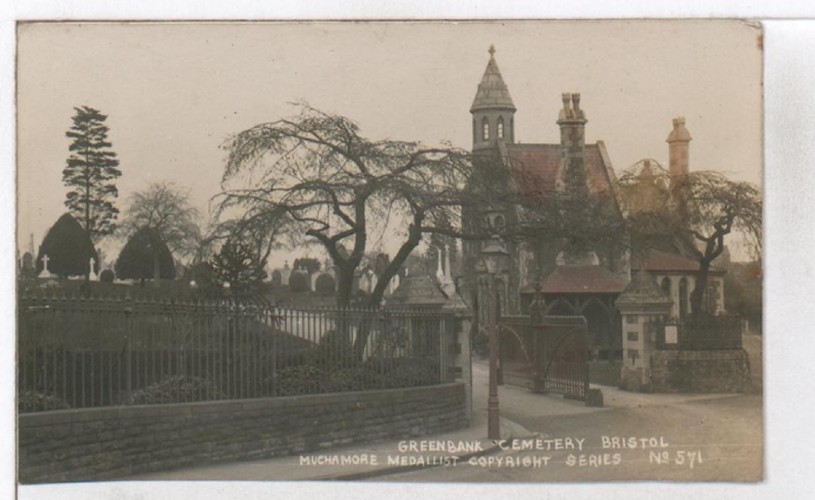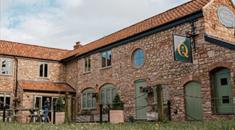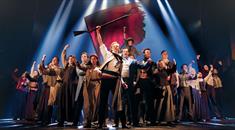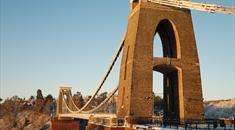Bristol is home to some of the most striking cemeteries in the country. Haunt Bristol has already featured the city’s largest, Arnos Vale Cemetery – with its two splendid chapels, in our interview with Janine Marriott, where we explored 10 fascinating facts about the site. Cemeteries are part of Bristol’s fabric as a place, with Arnos Vale appearing, too, in the ‘Top 20 Spring Walks around Bristol’.
In this article, writer and historian Dr Helen Frisby (University of the West of England) writes about Bristol’s second largest Victorian cemetery – Greenbank, which is itself steeped in history (check out this excellent blog post on the topic by Burials and Beyond). Perhaps most notably, Greenbank holds memorials to locals who died in the Bristol Blitz of 1941. But there is much more to see and think about.
Encouraging us to view cemeteries as places of imagination and oral histories, Dr Frisby explores the traditional funeral customs of early 20th century Bristol by inviting us to think about the man ‘with dark red hair’ – a figure from a fascinating story recounted to her by one of the gravediggers at Greenbank.
The man with dark red hair
Once I had the privilege, as part of a research project, to interview a retired gravedigger who used to work at Greenbank cemetery. We met by the staff messroom and sat outside there (I got sunburned), and he told me all about what it had been like to work there. One of his tales has particularly stuck with me ever since, and comes back to mind whenever I walk through there now.

Image - A postcard of Greenbank Cemetery, credit Bristol Archives, 43207/14/2.
Looking at old photographs of Greenbank, and comparing them with the scene nowadays, it’s striking how packed in all the monuments were back then. During the 1980s and 90s Bristol City Council undertook extensive site clearances, during which tombstones were removed by knocking them into the graves below. The gentleman I interviewed had been involved in this task, and decades later was still clearly affected by his memories:
“the person in [the exposed grave] had a beautiful red head of hair, red hair, dark red hair and he did look very reproachful … I hope he is not up there and looking down on me.”
Since then I’ve imagined that red-haired man; forgotten now, but once a person known and loved (or who knows, maybe hated?), mourned and missed. Was his death a sudden surprise; or did they hear the owls hooting or the dogs howling, and wonder who was going to die? Maybe somebody found a ‘coffin’ (oblong-shaped coal) in the fire, or magpies (‘four’s a burying’) were spotted hanging round the house. Thankfully this latter one has since become softened to mere bad luck – as has that other Victorian death portent, the broken mirror.
Alternatively, perhaps some foolish individual had tempted fate by bringing a piece of blossom indoors or putting boots on the table. With life so precarious back in those pre-antibiotic days, these and numerous other such beliefs were widespread even amongst the educated.
Traditional Funeral Customs
When our red-haired gentleman died, his body was laid out wearing the suit our gravedigger would see still so well preserved on him decades later. Depending on when he died, this service might have been performed by the local layer-outer; then as the 1920s and 30s progressed, this task increasingly was carried out by professional undertakers.
.jpg)
Image - A postcard of Greenbank Cemetery from the 1920s, credit Bristol Archives, 43207/14/3.
Let’s assume however that our man rested at home, with friends and neighbours coming round to observe the traditional custom of laying a hand on his cold skin in one last touch of affection or reconciliation. The more superstitious among them would have hoped that doing this would prevent his spirit haunting them. Inside the bereaved home, covered mirrors and open windows ‘to let the soul out’, together with the stopped clock, emphasised to all present that normal life and time were temporarily paused.
Did our man’s family find all these visitors comforting, I wonder? Or perhaps entertaining and feeding them all was just another thing to do at an already difficult time. And the visitors; were they there to pay sincere respects, out of social obligation or merely to nosy inside the house (or for the funeral cake)? We’ll never really know, but perhaps some answer lies in the fact that when chapels of rest arrived from America in the 1930s, they proved instantly popular in Bristol and elsewhere.
On the funeral day, then, invited guests would gather at the house for refreshments; a difference to nowadays, where most mourners assemble instead at the ceremony venue. Sometimes ‘doles’ of black armbands, ‘weepers’ or gloves were distributed, the quality of these items carefully matched to the status of the guest. The coffin was customarily carried by its bearers out of the front door, feet first. What an emotional impact this piece of ritual drama, the final departure without looking back, must have had upon those in attendance.
The Final Journey
As our red-haired man went along his final journey from home to the cemetery, bystanders would have paused to watch his coffin process by – headgear respectfully removed, and mindful also perhaps of the then widespread folk belief that it was bad luck to meet a funeral! This longtime custom of ‘standing’ funerals has recently been making a comeback, in consequence of the Covid pandemic restrictions upon attendance at funeral services.
When walking through Greenbank, I can’t help but think how many such solemn processions must previously have paced through the gates and along these same paths. Sometimes I even fancy, in a not-at-all-scholarly manner, that right at the edge of my sight there flickers the ghost of an old style funeral carriage, pulled by beplumed horses and headed by a black-clad mute or two. Apart from the clip-clop of the horses’ hooves and patter of the ubiquitous Bristol rain, one imagines how the only other sound – no twenty-first century rumble of traffic back then – must have been the lugubrious toll of the cemetery’s chapel bell, counting out the years of the deceased’s life in measured step.
As our man’s coffin was lowered into its grave his friends and relatives might well have thrown flowers, and/or sprigs of rosemary ‘for remembrance’ in after it. Perhaps as they did so they sang a decorous Victorian hymn such as ‘Abide With Me’; or possibly the much older, wilder Lyke Wake Dirge, a folksong depicting the soul’s perilous postmortem journey across a field of thorns. Although belief in Purgatory was long since gone by this time, there’s still the clear sense here that the living should help the newly dead get to wherever they might be going.
Meanwhile back at home, the (always female) ‘servers’ would have been setting the funeral tea out ready for the returning mourners. If the house wasn’t big enough, then a local schoolroom or similar would have been pressed into service for this event. Then as nowadays, a good solid meal after the service was an important part of the send-off, an opportunity for the bereaved to bond over food and drink while facing up to the future.
What I’ve described above was (probably) a fairly typical funeral around the time our red-haired man (probably) died. The truth is that we’ll never know for certain – as for so many of those who’ve found their final resting-place at Greenbank, his circumstances are slipped out of memory, and thanks to the subsequent clearance even his grave now lies unmarked. Perhaps that’s the fate which awaits all of us eventually, one way or another, to be forgotten as time and the world move on. This I think is the fascination which keeps on drawing me back to Greenbank cemetery – where today’s landscape conceals its most secret memories away from even the most prying of research historians.
About the author
Dr Helen Frisby is a Visiting Research Fellow at the Centre for Death and Society, University of Bath. She researches, publishes and speaks on the history and folklore of death, dying and bereavement, including appearances on the History Channel and BBC. Helen is Secretary of the Association for the Study of Death & Society and a Council Member of the Folklore Society. She is author of the recent Shire book Traditions of Death and Burial.
You might also like:




 to add an item to your Itinerary basket.
to add an item to your Itinerary basket.







































